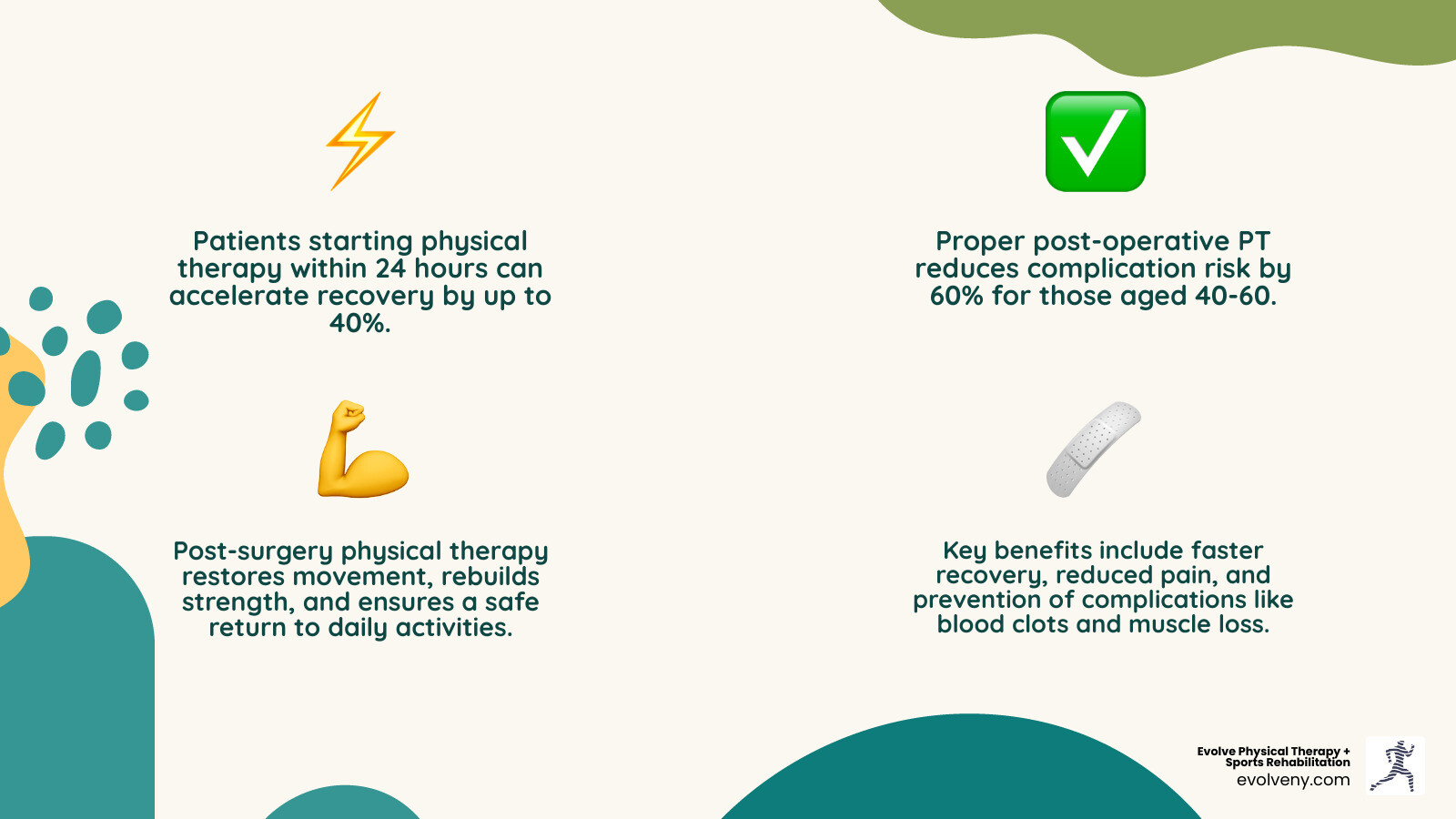Post-Op Power-Up: Your Guide to Physical Therapy After Surgery
Why Surgery is Just the Beginning of Your Healing Journey
Post surgery physical therapy is a critical component of recovery that helps you regain strength, mobility, and function after an operation. Here's what you need to know:
Quick Answer: What is Post-Surgery Physical Therapy?
- Purpose: Restore movement, rebuild strength, and return you to daily activities safely
- When to Start: Typically within 24-48 hours to 2 weeks post-op, depending on your surgery
- Duration: Ranges from 6 weeks to 6+ months based on procedure complexity
- Key Benefits: Faster recovery, reduced pain, prevention of complications like blood clots and muscle loss
- What to Expect: Graduated phases from gentle movement to functional strengthening
Surgery is only the first step. As one orthopedic surgeon notes, "the success of their procedures is highly dependent on a personalized physical therapy plan." Without proper rehabilitation, you risk improper healing, reduced range of motion, and chronic pain.
Limiting mobility during recovery can lead to serious complications. Your body needs guided movement to heal properly, prevent scar tissue buildup, restore circulation, and rebuild lost strength. Physical therapy provides a structured, evidence-based roadmap to full functional recovery.
Research shows that patients who begin physical therapy within 24 hours after surgery can accelerate their recovery by up to 40%. Those aged 40-60 who receive proper post-operative PT reduce their complication risk by 60%. These numbers represent the difference between a smooth recovery and months of unnecessary struggle.
I'm Lou Ezrick, founder of Evolve Physical Therapy in Brooklyn. With nearly two decades specializing in post surgery physical therapy, I've seen how the right rehabilitation approach transforms surgical outcomes.

Why Post-Surgical Physical Therapy is Essential for Your Recovery
After surgery, your surgeon has repaired the damage, but that's only half the battle. Your body has been through trauma, and without proper rehabilitation, you're leaving your recovery to chance. Post surgery physical therapy bridges the gap between the operating room and your real life, helping you recover your function, strength, and independence.
Pain and swelling management are among the first things we address. While medication helps, we use gentle manual therapy, targeted exercises, and modalities like ice to help your body manage pain naturally and reduce inflammation. Many patients find they need fewer pain medications when actively engaged in therapy.
Here's where PT becomes truly essential: preventing complications. Immobility is risky. It can lead to dangerous blood clots, muscle wasting within days, and stiff joints. For patients who've had abdominal or chest surgery, specialized breathing exercises can reduce the risk of lung complications by up to 40%.
We work on restoring your range of motion because stiff joints make everything harder. Using hands-on techniques and specific stretches, we help you move freely again. Every degree of motion we restore is a piece of your independence coming back.
Rebuilding muscle strength happens gradually and strategically. We design progressive exercise programs that safely challenge your muscles, building the stability and support your body needs. We also use soft tissue manipulation to break down restrictive scar tissue that can limit movement and cause discomfort.
The goal is improving your quality of life. We want you walking through Prospect Park, playing with your grandkids, or simply carrying groceries without a second thought. The psychological boost that comes from seeing yourself get stronger is powerful medicine.
Research backs this up. Studies on physiotherapy strategies for postoperative rehabilitation show that early mobilization prevents muscle atrophy, joint stiffness, and circulation problems. Our approach to post surgery physical therapy in Brooklyn follows these evidence-based strategies because they work. You can read more about optimizing recovery through physiotherapy strategies.
Surgery fixes the problem. Physical therapy makes sure you get your life back.
Your Recovery Roadmap: The Phases of Post Surgery Physical Therapy
Your recovery is a journey with distinct landmarks. Post surgery physical therapy follows a structured progression, with each phase building on the last to take you from initial healing to full function. Your timeline is unique, influenced by your surgery, health, and age. We work in close partnership with your surgeon, ensuring every step aligns with your body's healing.
Phase 1: The Acute/Protective Phase (Weeks 0-4)
This first phase is about protecting the surgical site to create the right conditions for healing. This may mean using a sling or limiting weight on a limb. We control pain and swelling with ice, compression, and elevation, ensuring exercises don't increase pain significantly. Even in this phase, movement is medicine. We guide you through passive range of motion exercises, where the therapist moves your limb, and simple ankle pumps to prevent blood clots. For shoulder surgeries, we use gentle pendulum swings, and for abdominal or chest surgeries, we focus on diaphragmatic breathing to reduce lung complication risks.
Phase 2: The Mobility/Early Strengthening Phase (Weeks 4-8)
As healing progresses, we start waking up muscles and reclaiming movement.

You become more active in your recovery, transitioning to active-assisted exercises where you do some of the work. Your therapist uses manual therapy to improve flexibility. Isometric exercises (contracting muscles without moving the joint) are key for rebuilding strength safely. We introduce light strengthening with resistance bands and begin proprioception training to help your body relearn its position in space, improving balance and coordination.
Phase 3: The Functional/Return-to-Activity Phase (Weeks 8+)
This is where you get back to living your life. We progress to more challenging exercises with weights and bands to build functional strength for real-life activities. Endurance and advanced balance exercises become a focus. For athletes, we design sport-specific drills, including agility and plyometrics, to prepare your body for the demands of your game. Research shows this step can help athletes return to sports 8-12 weeks sooner. We practice the movements specific to your life, ensuring you can perform them confidently and safely.
Common Treatments and Modalities Used in Post Surgery Physical Therapy
Throughout these phases, we use a toolkit of techniques:
- Manual therapy: Hands-on techniques to reduce pain, improve circulation, and restore movement.
- Therapeutic exercise: Custom-designed programs to restore strength, flexibility, and endurance.
- Heat and cold therapy: To manage pain, swelling, and muscle tightness.
- Electrical stimulation (TENS): Delivers mild electrical currents to block pain signals.
- Therapeutic ultrasound: Uses sound waves to promote tissue healing and reduce inflammation.
- Myofascial release: A manual technique to manage scar tissue and release deep tension.
- Gait training: Helps you relearn proper walking patterns and improve balance.
Your Partner in Recovery: The Role of You and Your Physical Therapist
Recovery from surgery is an active partnership. At Evolve Physical Therapy in Brooklyn, we see post surgery physical therapy as a team effort. We bring the roadmap and expertise; you drive the journey. Together, we'll steer the path from post-operative healing back to your life.
The Physical Therapist's Role: Your Expert Guide
Your physical therapist is a musculoskeletal expert who understands how the body heals. We practice evidence-based care, but we also recognize you're a whole person with unique goals. Our role includes:
- Comprehensive assessment: We evaluate your movement, pain, and strength to understand your starting point and what you hope to achieve.
- Custom treatment plan: We design a plan specifically for your body and surgery, collaborating closely with your surgeon.
- Monitoring and adjusting: We continuously track your progress, modifying the plan as you heal to overcome plateaus or advance your program.
- Patient education: We teach you the "why" behind each exercise and how to protect your body, empowering you with knowledge.
- Hands-on techniques: We use manual therapy to improve mobility, reduce pain, and break down scar tissue.
The Patient's Role: How to Maximize Your Results
Your active participation transforms good outcomes into great ones. You are the most important member of your recovery team. To maximize your results:
- Consider "pre-hab": Starting physical therapy before surgery can strengthen muscles and improve motion, giving your body a head start on recovery.
- Adhere to your home exercise program: The exercises we assign are your secret weapon. Consistency can reduce your overall healing time by up to 40%.
- Communicate openly about pain: We need to know what you're feeling. There's "good pain" (muscle soreness) and "bad pain" (sharp, stabbing). Never push through bad pain.
- Be patient and persistent: Recovery has ups and downs. Trust the process, and know we're here to support you through challenges and celebrate victories.
- Focus on nutrition: Your body needs adequate protein, vitamins, and minerals to repair tissues and build muscle.
Tailoring the Treatment: PT Protocols for Different Surgeries
Post surgery physical therapy isn't a cookie-cutter approach. What works for a hip replacement won't be right for an ACL reconstruction. Every surgery requires its own carefully crafted protocol, which we customize for your body, surgery, and timeline in collaboration with your surgeon.

Orthopedic Surgeries: Joint Replacements & Fracture Repair
For joint replacements (knee, hip, shoulder) or fracture repairs, the focus is on teaching your body how to use the new or repaired structure. This involves a careful weight-bearing progression, guided by your healing stages. We use gait analysis to correct limping or other compensatory patterns that can cause pain elsewhere. The goal is to restore joint mechanics for smooth, natural movement, whether you're climbing stairs in Midwood or walking in Prospect Park.
For more details, you can explore this resource: Read about specific rehabilitation protocols.
Soft Tissue Repairs: ACL, Rotator Cuff, and Tendons
Soft tissue surgeries (ACL, rotator cuff, Achilles tendon) require a delicate approach. Protecting the repaired tissue is critical, often involving a sling or restricted movement for several weeks to prevent re-injury. We use gradual loading strategies, introducing stress in tiny, calculated increments to allow the tissue to build strength without being overwhelmed. For example, rotator cuff rehab prioritizes restoring motion before adding resistance, a process that requires patience and precision over several months.
Here's an example of a detailed rotator cuff repair guide: Example of a rotator cuff repair protocol.
Abdominal and Core Surgeries
After hernia repair or other core surgeries, we focus on rebuilding strength while protecting the incision. We teach core stabilization exercises that engage deep muscles without straining the repair. Diaphragmatic breathing is a foundational technique. We enforce strict lifting precautions and teach proper mechanics to avoid strain. You'll also learn simple but crucial techniques like self-splinting (using a pillow for support when coughing) to manage discomfort and protect the healing tissues.
For a comprehensive look at this process, check out this guide: View an abdominal core surgery rehab guide.
The bottom line is that we have the expertise to guide you through a surgery-specific, personalized rehabilitation program that respects your body's healing timeline while pushing you toward your recovery goals.
Frequently Asked Questions about Post-Surgical Physical Therapy
It's normal to have questions about your recovery. We've guided hundreds of patients through their post surgery physical therapy journey in Brooklyn, and here are answers to the most common concerns.
When should I start physical therapy after surgery?
Your surgeon gives the final okay, but modern research favors early mobilization. For many procedures, starting gentle movements within 24-48 hours can prevent complications like blood clots and accelerate recovery by up to 40%. These initial movements are simple, like ankle pumps in bed. The formal start of outpatient PT may vary from a few days to a couple of weeks post-op, depending on the surgery, but the principle of early, safe movement is key.
How long will I need post-surgical physical therapy?
Recovery timelines are unique. The duration depends on the type of surgery (a minor procedure may need 6 weeks; a complex repair can take 6+ months), your overall health, and your recovery goals. Returning to competitive sports will take longer than returning to comfortable daily walks. Patients who are consistent with their home exercise program often heal significantly faster. We'll provide a realistic timeline at your first visit and adjust it as you progress.
Will physical therapy be painful?
Some discomfort after surgery is normal, but physical therapy should not cause "bad" pain. Our job is to work with you to distinguish between "good pain" (the muscle soreness that signals progress) and "bad pain" (sharp, stabbing, or worsening pain that is a warning sign). Our rule is that exercises shouldn't increase your pain by more than 2 points on a 10-point scale. Communication is everything. Your honest feedback allows us to adjust your program to a challenging but safe level. The goal is a productive, manageable recovery, and most of our patients feel better after their sessions, not worse.
Conclusion: Taking the First Step on Your Road to Recovery
Surgery is just the beginning. The real change happens in the weeks and months that follow, and post surgery physical therapy is your most powerful tool for a successful recovery.
This process empowers you to take control, actively rebuilding your body and your confidence. By committing to rehabilitation, you're investing in reduced pain, faster healing, and the prevention of long-term complications. You're building a stronger, more resilient version of yourself.
At Evolve Physical Therapy + Sports Rehabilitation, we've guided countless Brooklyn residents through this process. Our hands-on, personalized approach partners with you to achieve your goals, whether that's walking in Prospect Park or returning to your sport. We've seen patients who could barely walk return to running marathons—this is what happens when expert guidance meets patient dedication.
Your recovery is too important to leave to chance. Taking that first step toward proper rehabilitation is the best decision you can make for your surgical outcome.
Ready to begin? We're here to guide you every step of the way.


